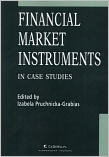Financial market is the core of the economy. It has a profound impact on many of its
sectors and allows it to function properly. It is due to various financial instruments
which are created to fulfill needs of its participants. They are more and more complex and
thus better and better tailored to their users' necessities.
The book presents some of these products, especially those which are not well
developed on the Polish market that is mortgage instruments, foreign
exchange forwards, options, credit derivatives and structured
products. The aim of its Authors was to show the difference between the Polish
and other markets. It was reached by giving these products characteristics and the present
state of development in the world markets as well as in Poland.
The book, prepared by economists from the best Polish universities, is devoted to
students, scientists as well as to existing and potential investors of the Polish
financial market. Being written in English, I am sure it will have a great deal of not
only Polish but also foreign readers.
Editor
Contents
Foreword by Izabela Pruchnicka-Grabias
Chapter 1 Principles of the Law on the Capital Market in the European Union and
in Poland - Justyna Maliszewska-Nienartowicz
1.1. Introductory Remarks
1.2. Definitions of Basic Concepts - the Capital Market and the Law on the Capital Market
1.3. Principles of the Law on the Capital Market in the EU
1.3.1. Regulations Concerning Different Sectors of the Capital Market
1.3.2. Basic Characteristics and Principles of the Public Market
1.3.3. Principles of the Regulated Market and Relating to Investment Firms and Services
1.3.4. Basic Characteristics and Principles of the Official Stock-exchange Listing Market
1.4. Principles of the Law on the Capital Market in Poland
1.4.1. Acts on Public Offering, on Trading in Financial Instruments and on Capital Market
Supervision - the Most Important Changes in Comparison with Previous Regulations
1.4.2. Basic Principles of the Polish Capital Market
1.4.2.1. The Principle of the Dematerialisation of Securities and Trading in Securities
(Financial Instruments)
1.4.2.2. The Principle of Trading on the Regulated Market
1.4.2.3. The Principle of the Obligatory Intermediation of an Investment Firm Conducting
Brokerage Activities
1.4.2.4 The Principle of Administrative Supervision
1.4.3. The Need for Further Development of Polish Regulations on Capital Market
Chapter 2 Mortgage Financial Instruments in European Countries - Anna
Szelągowska
2.1. Covered Bonds
2.2. Structured Covered Bonds
2.3.Residential Mortgage Backed Securities
2.4. Retail Deposits
2.5. Securitisation
2.6. Multi-origination Platforms
2.7. The Covered Bond Systems in Europe
2.8. Case Study of the Polish Mortgage Market
Chapter 3 Foreign Exchange Forward as an OTC Derivatives Market Instrument
- Iwona Piekunko-Mantiuk
3.1. The Essence of Forward Contracts
3.2. Using the Forward Transaction to Secure the Open Foreign Exchange Position
3.3. The Global Market of Forward Contracts
3.4. Forward Contract Markets in Selected Countries
3.4.1. Developed Markets
3.4.1.1. Great Britain
3.4.1.2. USA
3.4.2. Emerging Markets
3.4.2.1. Singapore
3.4.2.2. The Czech Republic
3.5. The Polish Foreign Exchange Forward Market
3.5.1. Innovations on the Polish Foreign Exchange Forward Market
3.5.2. Turnover Volume and Structure
3.5.3. Development Perspectives
Chapter 4 Focus on Options - Izabela Pruchnicka-Grabias
4.1. Risk Factors Associated with Options
4.2. Options Listed on Well-developed Exchanges in the World
4.3. Options in Poland
4.4. Options' OTC Markets in 2001-2006
Chapter 5 Credit Derivatives in the United States and Poland - Reasons for
Differences In Development Stages - Paweł Niedziółka
5.1. Characteristics of Credit Derivatives - Selected Aspects
5.2. Credit Derivatives Market in the United States
5.3. Credit Derivatives in Poland - Reasons for Slow Market Development
Chapter 6 Structured Products - Krzysztof Borowski
6.1. Structured Products - Origin
6.1.1. Development of the Structured Products Market
6.2. Structured Products Classification
6.2.1. Principal Protected Products
6.2.2. Single - Stock Hedges
6.2.3. Other Classification of Structured Products
6.3. Examples of Structured Products
6.3.1. Capital Protected Products
6.3.2. Trackers
6.3.3. Accelerated Trackers
6.3.4. Reverse Trackers
6.3.5. Bonus Trackers
6.3.6. Discount Trackers
6.4. Structured Products Listed on the London Stock Exchange (LSE)
6.4.1. Income Products
6.4.2. Lock - in Certificates
6.4.3. Air - bag Certificate
6.5. Structured Products on the Warsaw Stock Exchange (WSE)
6.6. Recent and Expected Trends
Concluding Remarks by Izabela Pruchnicka-Grabias
Bibliography
Paperback, B5, 156 pages


